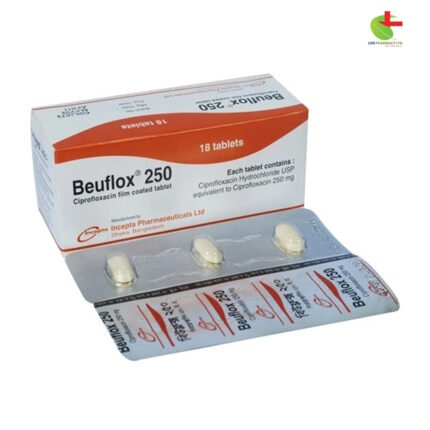Beuflox 500
150.00৳ Strip
- Beuflox is a broad-spectrum antibiotic effective against various bacterial infections, including resistant strains.
- Indicated for severe systemic, respiratory, urinary, and skin infections, as well as gonorrhea.
- Offers excellent tissue penetration and antibacterial activity.
- Can be used alone or in combination with other antibiotics.
- Always consult a healthcare professional before use.
 Brand
Brand
|
Incepta Pharmaceuticals Ltd |
|---|---|
 Generics
Generics
|
Ciprofloxacin |
 Type
Type
|
Tablet |
Indications for Beuflox
Beuflox is prescribed for the treatment of both single and mixed infections caused by two or more susceptible organisms. It is effective against infections from bacteria resistant to other antibiotics, including aminoglycosides, penicillins, and cephalosporins.
Due to its ability to reach antibacterial concentrations in serum, body tissues, and urine after oral administration, Beuflox is recommended for a variety of infections, including those affecting the urinary, respiratory, and gastrointestinal tracts, as well as gonorrhea and septicemia. Its extensive tissue penetration and enhanced antibacterial efficacy—particularly against Pseudomonas—allow it to be used alone (pending sensitivity results) or in combination with aminoglycosides or beta-lactam antibiotics, especially in cases of severe neutropenia or when Bacteroides fragilis is suspected.
Beuflox is indicated for treating the following infections caused by sensitive bacteria:
- Severe Systemic Infections: Including septicemia, bacteremia, peritonitis, and infections in immunocompromised patients with hematological or solid tumors, as well as those in intensive care with complications like infected burns.
- Respiratory Tract Infections: Such as lobar pneumonia, bronchopneumonia, acute and chronic bronchitis, exacerbations of cystic fibrosis, bronchiectasis, and empyema.
- Urinary Tract Infections: Both uncomplicated and complicated cases of urethritis, cystitis, pyelonephritis, prostatitis, and epididymitis.
- Skin and Soft Tissue Infections: Including infected ulcers, wound infections, abscesses, cellulitis, otitis externa, erysipelas, and infected burns.
- Gastrointestinal Infections: Such as enteric fever and infective diarrhea.
- Biliary Tract Infections: Including cholangitis, cholecystitis, and gallbladder empyema.
- Intra-abdominal Infections: Such as peritonitis and intra-abdominal abscesses.
- Bone and Joint Infections: Including osteomyelitis and septic arthritis.
- Pelvic Infections: Such as salpingitis, endometritis, and pelvic inflammatory disease.
- Eye, Ear, Nose, and Throat Infections: Including otitis media, sinusitis, mastoiditis, and tonsillitis.
- Gonorrhea: Including urethral, rectal, and pharyngeal infections caused by beta-lactamase-producing organisms or those with moderate sensitivity to penicillin.
Pharmacology
Ciprofloxacin is a synthetic quinolone antibiotic known for its broad spectrum of activity. It is effective against most gram-negative aerobic bacteria, including Enterobacteriaceae and Pseudomonas aeruginosa. Additionally, it acts on gram-positive aerobic bacteria, including both penicillinase-producing and non-penicillinase-producing strains, as well as methicillin-resistant staphylococci; however, many Streptococcus strains exhibit relative resistance. The bactericidal effect of Ciprofloxacin is due to its interference with the enzyme DNA gyrase, essential for bacterial DNA synthesis. After oral administration, it is rapidly absorbed from the gastrointestinal tract and widely distributed throughout body tissues and fluids. The drug has a half-life of approximately 3.5 hours, with about 30% to 50% of an oral dose excreted unchanged in urine within 24 hours.
Dosage Recommendations
The dosage of Ciprofloxacin depends on the infection’s severity, type, the sensitivity of the causative organisms, and patient-specific factors such as age, weight, and renal function.
- Adults: Recommended dosage ranges from 100 to 750 mg twice daily.
- Lower and Upper Urinary Tract Infections: 250-500 mg twice daily, depending on severity.
- Respiratory Tract Infections: 250-500 mg twice daily; for known Streptococcus pneumoniae infections, 750 mg twice daily is advised.
- Gonorrhea: A single dose of either 250 mg or 500 mg.
- Other Infections: Generally, 500-750 mg twice daily is recommended.
- Cystic Fibrosis: Adults with pseudomonal infections typically receive 750 mg twice daily, considering their lower body weight.
- Impaired Renal Function: Dosage adjustments are usually not necessary, except in cases of severe impairment (serum creatinine >265 µmol/L or creatinine clearance <20 mL/min), where the total daily dose may be halved.
- Elderly: No dosage adjustment is needed despite higher serum levels.
- Adolescents and Children: Ciprofloxacin is not typically recommended for growing children due to potential arthropathy risks. If necessary, dosage should be 7.5-15 mg/kg/day, divided into two doses.
Duration of Treatment: Varies based on infection severity, clinical response, and bacteriological findings. For acute infections, a typical treatment period is 5 to 10 days, continuing for three days after symptoms resolve.
- Extended-Release Tablets: In uncomplicated urinary tract infections (acute cystitis), the recommended dose is 1000 mg once daily for three days.
For IV Infusion:
- Urinary Tract Infection: 200 mg every 12 hours for mild to moderate cases; 400 mg every 12 hours for severe cases over 7-14 days.
- Lower Respiratory Tract Infection: 400 mg every 12 hours for mild to moderate cases; 400 mg every 8 hours for severe cases over 7-14 days.
- Nosocomial Pneumonia: 400 mg every 8 hours for 10-14 days.
- Skin Infections: 400 mg every 12 hours for mild to moderate cases; 400 mg every 8 hours for severe cases over 7-14 days.
- Bone and Joint Infections: 400 mg every 12 hours for mild to moderate cases; 400 mg every 8 hours for severe cases over 4-6 weeks.
- Intra-abdominal Infections: 400 mg every 12 hours for 7-14 days in complicated cases.
- Acute Sinusitis: 400 mg every 12 hours for 10 days.
- Chronic Bacterial Prostatitis: 400 mg every 12 hours for 28 days.
Use only under the guidance of a registered healthcare professional.
Administration Instructions for Ciprofloxacin IV Infusion:
- Inspect the bag for leaks by squeezing it gently. Discard if leaks are found or if the seal is compromised.
- Do not use if the solution appears cloudy or has precipitate.
- Avoid flexible bags in series connections.
- Close the flow control clamp of the administration set.
- Remove the cover from the port at the bottom of the bag.
- Insert the administration set’s piercing pin into the port with a twisting motion until secure.
- Hang the bag from a suitable hook.
- Squeeze and release the drip chamber to establish the appropriate fluid level during the infusion.
- Open the flow control clamp to eliminate air from the set, then close it.
- Regulate the administration rate with the flow control clamp.
Use only under the guidance of a registered healthcare professional.
Interactions:
Beuflox should not be administered concurrently with magnesium or aluminum-containing antacids, sucralfate, or supplements containing calcium, iron, or zinc. These can be taken two hours after or six hours before Beuflox. Additionally, avoid taking Beuflox with milk or dairy products, as they can significantly reduce its absorption. Dietary calcium consumed as part of a meal does not affect absorption.
Contraindications:
Beuflox is contraindicated in patients with a known hypersensitivity to Ciprofloxacin or other quinolones.
Side Effects:
Common side effects may include gastrointestinal disturbances such as nausea, diarrhea, vomiting, and abdominal pain. Central nervous system effects can include headache, dizziness, confusion, and in rare cases, seizures or retinal detachment. Hypersensitivity reactions, including skin rashes (very rarely, Stevens-Johnson syndrome or toxic epidermal necrolysis), pruritus, and systemic reactions, may also occur. Other less frequent reactions may include joint pain, mild photosensitivity, and transient increases in liver enzymes.
Pregnancy & Lactation:
Reproductive studies in animal models have not shown teratogenic effects. However, due to the potential for arthropathy in immature animals, Ciprofloxacin is not recommended during pregnancy. It is also secreted in milk; therefore, it should not be given to nursing mothers.
Precautions & Warnings:
Use Beuflox cautiously in patients with known or suspected central nervous system disorders, such as arteriosclerosis or epilepsy. It can be taken with or without food, and ample fluids should be consumed during treatment. Avoid concurrent use with certain antacids and dairy products, as noted previously.
Use in Special Populations:
While effective in clinical trials, Beuflox is not typically the first choice for pediatric patients.
Overdose Effects:
Overdosing on Beuflox may lead to seizures, hallucinations, confusion, abdominal discomfort, and potential renal and hepatic impairment, as well as crystalluria and hematuria.
Therapeutic Class:
4-Quinolone preparations, anti-diarrheal antimicrobial drugs.
Storage Conditions:
Store below 30°C, away from light and moisture. Keep out of reach of children.













Reviews
There are no reviews yet.